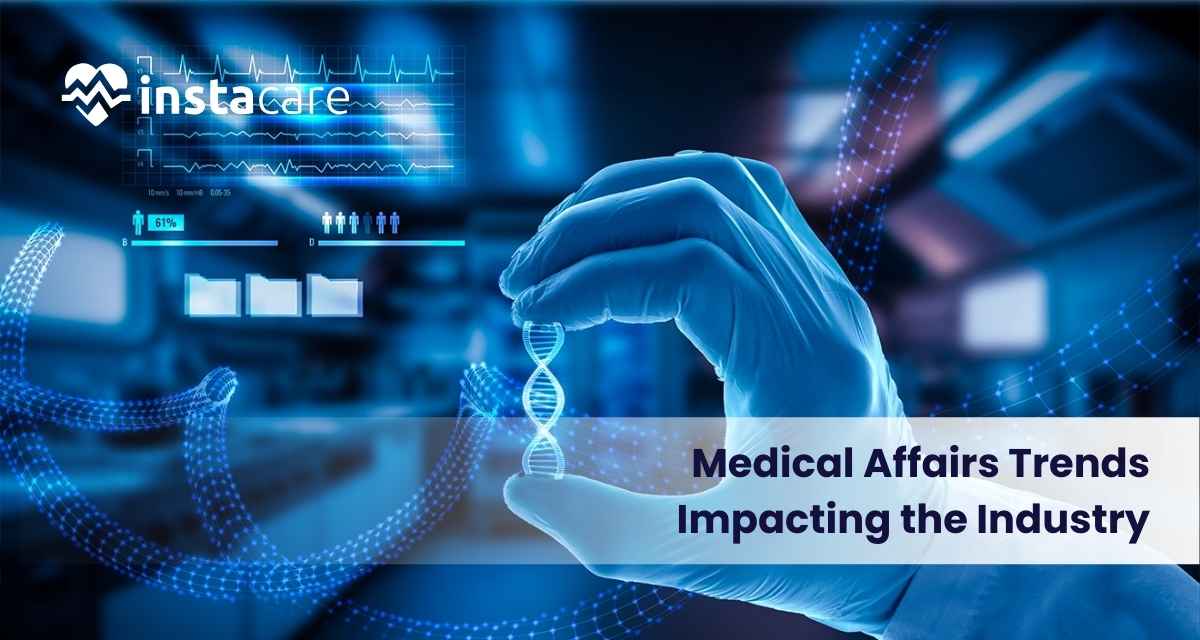Last updated on Wednesday, 4, September, 2024
Table of Contents
3 Medical Affairs Trends Impacting the Industry
The ideal landscape of medical affairs is being driven by technological innovations, evolution in regulations, and the growing needs of an increasingly demanding patient base pressing for more patient-centeredness into care. The professionalism of medical affairs is called upon by properly ensuring that new scientific knowledge is diffused into practice adequately at the apex of the clinical practice–regulatory–pharmaceutical triad. Being successful in a very dynamic field, it has become very necessary for professionals to stay attuned to changing trends within their respective industries. The article is going to cover current trends incorporated in medical affairs that are useful today and lie at the core of shaping the future concerning healthcare and pharmaceutical innovation.
1- The Rise of Digital Health and Integration of Technology
Digital health technologies are innovating the way medical affairs work through new tools and platforms for better communication, data analysis, and decision-making. Not a fleeting trend, technology’s role in medical affairs has been a fundamental shift changing industries.
Improved Analytics and Insights:
Perhaps the most important influence of digital health on medical affairs is the sophisticated application of data analytics. All these technologies of big data, AI, ML have been used to analyze bundles on healthcare data with their possible insightful results, which otherwise would be hard to get. That puts medical affairs professionals in a position where they have to follow through on trends more closely, prove to be better at prognosis, and allow data-driven decisions to help improve quality in clinical trials, drug development, and patient care.
Virtual Engagement and Communication
The pandemic has vastly accelerated the transition to virtual engagement tools, and this is unlikely to be reversed. Medical affairs professionals will increasingly look for meeting, conference, and discussion venues with HCPs on virtual platforms. Virtual engagement does have its own advantages, which include easily reaching a global audience, reducing travel costs, and sharing updates in medical information on a timely basis.
Virtual advisory boards, webinars, and digital content dissemination are fast becoming business as usual for maintaining strong relationships with key stakeholders while the medical affairs team learns to adapt to new demands brought about in a digital world. This shift will also meet the increasing on-demand requirement for medical information that HCPs express by engaging at their convenience with content.
2- Patient-Centricity and Real-World Evidence
A few years ago it was nothing but the buzzword du jour, but now patient-centricity has been taken up by medical affairs teams as a tenet on which to ground their strategy and operations. And the patient is very relevant to the success of new therapies and medical innovations now.
Patient Engagement in Research and Development
It is one of the biggest trends: patient orientation, which gives even more impetus to increase the involvement of patients in the R&D process. Medical affairs teams work with patients to understand their experience, preferences, and unmet needs. Great importance is placed on the value contributed by patients to the improvement of study designs in regard to clinical trials, the relevant endpoints, and new therapy relevance in the real world.
PROs are rapidly becoming an established constituent of clinical trials that tell perception directly by patients about treatment benefits against side effects. This more than slightly raises tennis of certainty that new drugs will not only meet regulatory requirements established by the authorities but also bring meaningful benefits for patients.
Real-World Evidence
Real-world evidence and patient-centricity, thus, run hand in hand. Medical affairs teams drive how RWE can complement the use of classical clinical trial data through the provision of a complete picture of the effect a therapy will have on various patient populations. Real-world evidence really comes into its own in the domain of long-term outcomes, rare side effects, and treatment efficacy in standard practice.
This further shifts the emphasis to RWE, which has already had a bearing on regulatory decisions recently as agencies like the FDA make more use of RWE in their reviews. What this trend does is to place a critical tag on the securing and analysis of data from real-world sources by medical affairs professionals in the processes of development and approval for new therapies.
3- Evolving Regulatory Landscape and Compliance
It is in continuous flux for pharmaceuticals, with new guidelines, policies, and standards continuing to emerge to try to grapple with the complexities in the modern healthcare. Staying current with the evolution of the regulations by Medical Affairs professionals and successfully charting the complexities within the regulatory environment is mandatory to avoid noncompliance.
Increased Scrutiny on Data Transparency
The data transparency trend continues to be rampant in the broader key trends of the regulatory landscape. Increasingly, this means increasing weight upon disclosures of clinical trial data, adverse event reporting, and real-world evidence by regulators. That is all driven by the need to ensure the public trust, safety of patients, and informed decision-making.
Medical affairs teams are keen on ensuring the data are communicated to regulatory bodies, health professionals, and patients in an accurate and transparent way. This, in effect, encompasses more than compliance with the law and actually dissemination of information proactively with the view of supporting safe use and effective treatments.
Global Harmonization of Regulations
The more globalized the industry becomes, the stronger the push is toward the international harmonization of regional regulatory standards. Organizations like the International Council for Harmonisation of Technical Requirements for Pharmaceuticals for Human Use are trying to harmonize better regional guidance in such a way that it is going to be easier for a company to manage international markets.
This requires the medical affairs professional to have in-depth knowledge not only of the global regulatory environment but also of local requirements. A current international guideline to understand, then building collaboration between experts in the fields of medical affairs and regulatory science is very important to compliance and facilitating a global launch of new therapies.
Focus on post-marketing surveillance
Recently, interest from these areas of post-marketing surveillance by regulatory agencies has grown in order to maintain continual monitoring of the safety and efficacy of drugs after launch. It is an interest that reflects a continuous need for vigilance to ensure that problems are detected, which could appear once a therapy exposes a large section of the general population.
Medical affairs teams take the lead in post-marketing surveillance through the collection and analysis of data on adverse events, conducting risk assessments, and reporting back to regulatory bodies. All of these place a strong emphasis on post-marketing surveillance and much more proactive effort applied in the monitoring and management of therapies.
Conclusion
This, combined with a number of trends—the integration of digital health, patient-centric trends, and constantly changing regulatory requirements—re-shaped the profession of a medical affairs professional into adapting new technologies, creating innovative ways for engaging patients, and other stakeholders, and operating in an extremely complex regulatory environment.
Being aware of these trends, therefore, is crucial to the competitiveness and the effectiveness of the medical affairs team. By embracing digital tools, focusing on strategies that are becoming increasingly patient-centered, and staying up to date with changing regulatory requirements, medical affairs professionals will best be able to support the successful development and delivery of life-saving therapies. Those who can stay ahead of these trends will be in the best position to lead the way toward better patient outcomes and further healthcare innovation as this space continues to transform.
FAQs
How can medical affairs teams pull the lever of digital health technologies?
Medical affairs teams can conduct the overlay of advanced data analytics, AI, and machine learning over healthcare data to draw meaningful insights that would, in turn, empower well-informed decisions, ease clinical trials, and drive superior care for their patients. Such tools of virtual engagement provide proper articulation between the professional of health sciences and stakeholders; communication is done such that it facilitates the sharing of the medical information and building of relationships in a virtual setting.
How does patient centricity fit into medical affairs?
Patient-centricity in medical affairs means that the needs of patients are now included in the process of drug development and design of clinical trials. Meaning, they engage patients through real-world evidence in the process of developing therapies that answer actual challenges and in addressing meaningful benefits. This trend will not only enhance the outcomes of patients, but also keep up with the evolving and ever-increasing demand for personalized medicine.
Why can post-marketing surveillance be required in the pharmaceuticals sector?
Post-marketing surveillance is critically important within the pharmaceutical industry in that it establishes a way in which, following their licensing and dissemination to the broader population, drugs are followed up for continuous safety and efficacy. In the simplest form of explanation, post-marketing surveillance entails monitoring of adverse events, risk assessment, and communication of results of these undertakings to the regulatory agencies.



